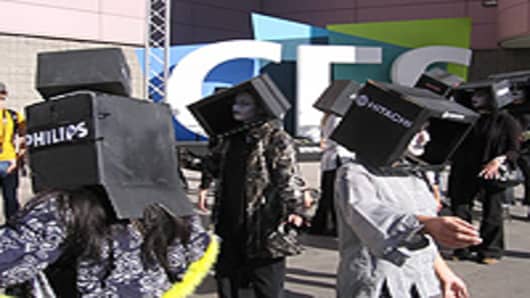This year’s CES could mark the turning point where green goes from buzzword to business-as-usual for electronics makers.
“We think ‘greenwashing’ is going to still be an issue, but underneath that, there is a trend that will be positive," says Greenpeace's Daniel Kessler.
That's because this year's biggest green improvements are more likely to reflect incremental efforts in corporate design and policy that get built into all electronics—rather than marketing-driven, green-themed products or brands for people with fat wallets—spurred by a convergence of economic and regulatory pressures.
“There is the notion that green costs money,” says Parker Brugge, VP of environmental affairs for Consumer Electronics Association, CEA,, the trade group that organizes CES, alluding to past trends of premium prices on green products. “We’re able to document where they save money.”
That may not have been the case at last year's show, where Samsung rolled out the Reclaim cell phone, with a recycled plastic case derived from old soda bottles, not old cell phones, and Fuji promoted the EnviroMAX battery, which the firm called “landfill friendly.”
Energy Efficiency
Making every gadget more energy efficient is one big trend for 2010
“A power supply is a power supply is a power supply” says Climate Savers Computing Initiative, CSCI, Executive Director Pat Tierney. “It’s a pretty well-known technology. But the average desktop computer wastes 50% of power coming from the wall (socket)."
His organization, a coalition of consumer, non-profit and business groups aiming to make the computer sector more environmentally friendly, wants to move from a 50%-efficiency rate to a 95% one by squeezing every component of a device’s power supply.
Tierney, a former VP of sustainability at Hewlett Packard, says the commoditized nature of power supply components means scale can come with a relatively small price premium, but that compliance standards, like the US Environmental Protection Agency’s Energy Star branding, are needed to create sufficient end-user awareness. And if big customers buy it, you’ll see it in every piece of home electronics.
“What gets adopted in industry has a lag time to the consumer world,” he says.
“We’ve seen energy efficiency improvements in every single technology,” adds CES’ Brugge. “There’s no single silver bullet—they all use energy—but the products are quite a bit different today than they were two, five or ten years ago.”
Energy efficiency progress comes with technological improvements in everything from processing chips to displays, he says.
Regulation also has a role in shaping business decisions, he says, but his membership wants to avoid limits on the power by technology category, like the California law passed last November limiting TV power usage. "“Certain technologies may never be brought to market.”
E-Waste And Recycling
Another CES green trend will revolve around e-waste and consumer takeback policies.
Lawmakers at all levels of government have been tackling the issue, since consumer electronics make up a large part of municipal solid waste streams, both in terms of sheer bulk and of toxic compounds.
Cities like New York, as well as 19 states, have passed producer takeback laws, forcing post-consumer recycling programs on manufacturers that go into effect over the next two years. Programs in Washington state and Oregon, launched in January 2009, collect over 4.5 million pounds of e-waste per month.
In 2006, computer maker Dell began taking back anything with its logo on it, free of charge, after pressure from consumer and environmental groups.
Rivals Hewlett-Packard , Lenovo , and Toshiba followed suit, as did as TV manufacturers LG , Mitsubishi, Panasonic , Sharp and Sony.
Expect firms attending CES to get inventive to ensure consumer compliance, says Tierney. This could mean door-to-door removal, cash-back programs or other enticements, all of which will likely drive up retail prices.
But he says that while it’s still more stick than carrot at this point, creating a supply of waste components should spur domestic recycling and recovery of the valuable components found in consumer electronics—like gold, platinum and other heavy metals—and hopefully put an end to off-shoring waste to developing countries with little oversight.
Still, he says, while laws push the marketing effort onto producers, consumers also need incentives. “Even if you have the optimal system set up, you’ve got to get [consumers] to act,” he says.
Bottom Line
CEA’s Brugge says that consumers and investors with a sustainability bent need to look at the overall impact of the consumer electronics sector when making a judgment, and not just at one-off products or programs.
“Our industry believes our products are part of the solution, not part of the problem,” he says, pointing out how, for example, improved meeting technology means less carbon-emitting and time-wasting travel.
Greenpeace’s Kessler agrees, and after going after some of these products at last year’s CES, the organization prefers to produce a report card tracking all of the environmental initiatives of consumer electronics firms.
It shows real progress, he says, and electronics shoppers are savvier now, about the green in the wallet and in their shopping bag. “The key for consumers is to see through that haze of greenwash,” he says.



